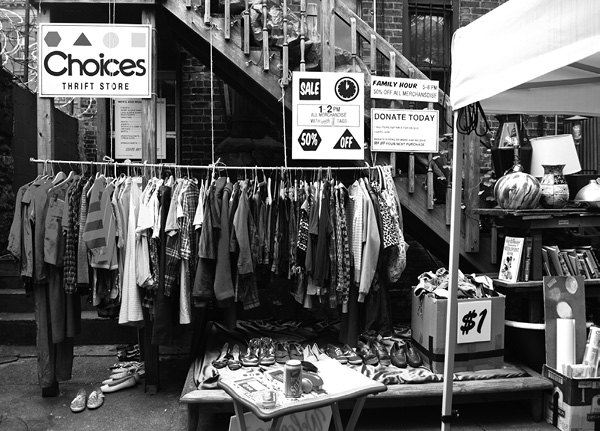
CHOICES THRIFT STORE
first performed on July 28, 2012
Soloway Gallery, New York, NY
performed once in 2012
CARMELLE SAFDIE
New York, NY
503248890c503248890a503248890r503248890m503248890e503248890l503248890l503248890e503248890s503248890a503248890f503248890d503248890i503248890e503248890@503248890g503248890m503248890a503248890i503248890l503248890.503248890c503248890o503248890m
npiece.com/carmelle-safdie
CHOICES THRIFT STORE
CARMELLE SAFDIE
“Choices Thrift Store” was open for one day in 2012. Located in the backyard of Soloway Gallery, “Choices” was one of twenty artist-run booths at this exhibition space’s fundraising Bazaar. Soloway had invited me—and a variety of other artists—to set up shop for a day-long market selling “artwork, edibles, multiples, services, or anything undefinable…” and asked that we give them 50% of our proceeds. “Choices Thrift Store” was created to address the problem of selling my artwork (e.g. paintings or prints) at an artist-run, artist-attended fair where the budget of the shoppers could not match the value, labor or expenses of my work. At “Choices” I was able to offer existing objects—potentially desirable and useful to my customers—for sale at affordable prices.
To ensure that “Choices” had something for everyone, I solicited donations from friends and colleagues, stocking the store with a wide array of items and clothing types (not excluding my own discarded belongings). I created a fixed price lists (e.g. shirts: $4, pants: $6, books: $1) and a color-coded discount system as a way to standardize and randomize value, letting the shopper find personal value in the objects with which they connected. As the store’s proprietor—handling all transactions—I became the lead performer, mediating between the items and customers that activated this work.
Creating this store was also an active way in which I was able to investigate my personal commitment to thrift shopping and better understand its relationship to my creative process. I used display, branding and signage to break down and highlight individual components of the second-hand shopping experience and foreground my aesthetic interest in this social endeavor. Colored tags (red, blue, green, orange, yellow, pink, purple and gray) featuring the geometric “Choices” logo were stapled or taped onto hundreds of pieces of used merchandise: clothing, shoes, accessories, bric-a-brac, household items and decor, small appliances, books, records, luggage and more. Clothing was organized by fabric color and hung in spectral order on garment racks. Small items and jewelry were consolidated into clear plastic baggies and larger objects were displayed on shelves and in bins. Meticulously crafted signs—featuring shapes, arrows, lettering and numbers—advertised the store’s name and logo, hours of operation, clothing prices, fitting room, donation policy, hourly colored tag sales and other discounts. My graphics—displayed on the street, in the gallery, amongst the merchandise and on my own body—guided customers through all aspects of the “Choices” shopping experience.